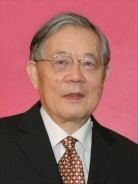Native name 周光召 Name Zhou Guangzhao Role Physicist | Years active 1957 - present Known for discovery of PCAC | |
 | ||
Alma mater Tsinghua UniversityBeijing University Organization Joint Institute for Nuclear Research, Chinese Academy of Sciences, Virginia Tech, CERN | ||
Zhou Guangzhao Professorship in Natural Sciences
Zhou Guangzhao (Chinese: 周光召; pinyin: Zhōu Guāngzhāo; born May 15, 1929) is a Chinese physicist who served as President of the Chinese Academy of Sciences from 1987 to 1997.
Contents
- Zhou Guangzhao Professorship in Natural Sciences
- Early life and education
- Professional career
- Honors
- References
Early life and education
Zhou Guangzhao was born on May 15, 1929 in Changsha, the capital of Hunan province. He was the 5th child of the civil engineer Zhou Fengjiu, and the younger brother of Chinese biochemist/geneticist Zhou Guangyu. He graduated from Tsinghua University in 1951, and then did graduate work in theoretical physics for three years at Beijing University. He stayed at Beijing Univ. on the faculty after completing his PhD. In 1957 he was sent to the USSR by the Chinese Atomic Energy Research Institute to work at the Dubna Joint Institute for Nuclear Research.
Professional career
Zhou returned to China in 1960, where he worked on the Chinese nuclear weapons program, ultimately becoming director of the Chinese Nuclear Weapons Research Institute. He was elected to the Chinese Academy of Sciences (CAS) and later became the Vice President (1984–1987) and President (1987–1997) of the CAS.
Zhou's theoretical work focuses on particle physics. He is credited for the discovery of PCAC (partial conservation of axial current), an important step toward the understanding of symmetry breaking.
He first visited the US in 1979. In the 1980s he spent time as a visiting researcher at Virginia Polytechnic Institute and at the European Organization for Nuclear Research in Switzerland. He was elected to the US National Academy of Science in 1987.
Honors
The asteroid 3462 Zhouguangzhao is named after him.
